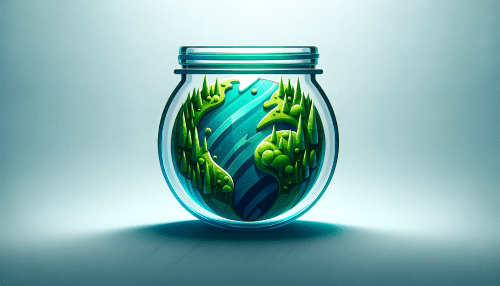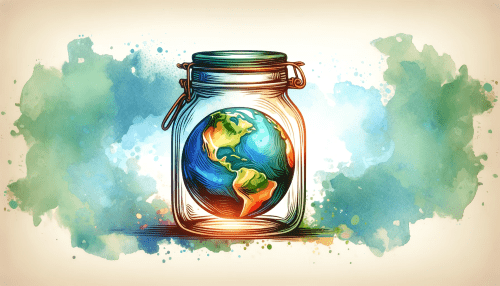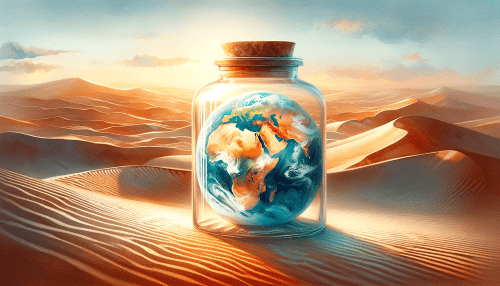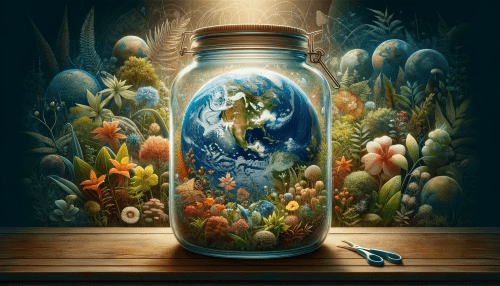Introduction:
In the profound silence of the forest, one can hear the subtle whispers of Earth’s most ancient tales. The third artistic theme of the “Earth in a Jar” subject, “The Planet Earth in a Jar, Showing Only Forests to Represent Nature,” eloquently captures this narrative. Each artwork in this quartet sings an ode to the sylvan spirits that inhabit our planet—a visual meditation on the integral role forests play not just in our ecosystems, but in the human psyche. These pieces are not mere paintings; they are portals into the heart of solitude and symbiosis, reminding us that even in isolation, there is a deep-seated interconnectivity that sustains us all.
The thumbnail image for this article is a vivid and thought-provoking portrayal that captures the viewer’s imagination. The centerpiece is a stylized Earth, encased in a clear glass jar, where the lush greens of dense forests are the focal point, representing the essence of nature’s vitality.
The forests depicted in this thumbnail are a rich tapestry of greens, ranging from the dark hues of the forest’s depth to the bright greens that dance in the light. They are intricately layered, conveying the complexity and diversity of woodland areas across the globe. The trees rise to embrace the Earth, almost as if they are nurturing it, providing a cradle for the planet’s life force.
The glass jar, transparent and pure, serves as a vessel for this representation of Earth. It is symbolic of the way we often attempt to contain nature, to hold it within our grasp and control it. The jar’s simplicity allows the Earth’s natural beauty to shine through unabashedly, while also suggesting a barrier, a delicate separation between the human touch and the wild spirit of the natural world.
The background is clean and unobtrusive, providing a soft, neutral space that brings the vibrant Earth and its forested surface to the forefront. This artistic choice ensures that the message is clear and that the beauty of the planet, with its verdant forests, is undisturbed and unchallenged.
The play of light and shadow in this image adds depth and a sense of realism. The shadow beneath the jar grounds the composition, offering a subtle reminder of the real-world implications of the subject matter – the environmental impact of human actions and the pressing need to preserve these green havens.
The image, as a whole, is not only a thumbnail for an article but also a statement piece that invites reflection on our interaction with the natural world. It is a visual prompt to consider the importance of conservation and the role that nature plays in the grand scheme of our planet’s health and our own well-being.
The planet Earth in a jar showing only forests to represent nature, Artwork 1
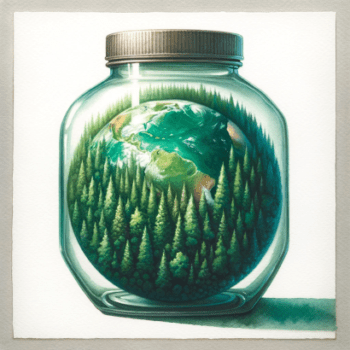
This compelling piece from the “Life in a Jar” series captures Earth in an unconventional portrayal, where the planet is not characterized by its familiar blue and green expanses, but instead by a lush tapestry of forests, encapsulated within the confines of a glass jar. Titled “The Planet Earth in a Jar, Showing Only Forests to Represent Nature,” it is the inaugural artwork in the third theme, which focuses on nature’s verdant realms.
The artwork presents the Earth as an orb of vitality, its surface completely enveloped by dense, rich canopies of trees. The forests are depicted with meticulous detail and varying shades of green, each tree rendered with a precision that conveys the sheer abundance and diversity of woodland life. The textures and tones used by the artist suggest the depth and complexity of the forests, from the dark, deep evergreens to the brighter, softer greens of deciduous foliage.
This forested Earth is cradled in a simple yet elegant glass jar, with a metal lid that gives a sense of containment and preservation. The jar’s transparency is masterful, allowing every intricate detail of the forests to be visible, highlighting the importance of transparency in our environmental consciousness. The curvature of the jar distorts and magnifies the forests, emphasizing the way in which we often see nature—a distortion through the lens of our human perspective.
The contrast between the organic shapes of the trees and the smooth, man-made lines of the jar creates a dialogue about the relationship between humanity and nature. It questions the ways in which we seek to preserve, control, and sometimes isolate the natural world, often forgetting that we are part of the biosphere we enclose.
In the background, the textured paper on which the watercolor is applied adds an additional layer of depth, its blank expanse serving as a canvas that allows the central image to stand out starkly. The shadow at the base of the jar anchors the piece, adding a subtle three-dimensionality and a sense of reality to the otherwise surreal depiction.
This artwork invites the viewer to reflect on the grandeur and beauty of Earth’s forests, the role of humanity as both protector and captor, and the essential connection we share with the natural world. It is a beautiful and thought-provoking start to a theme that celebrates the Earth’s natural environments while contemplating the nuanced dynamics of our stewardship and coexistence with nature.
The planet Earth in a jar showing only forests to represent nature, Artwork 2
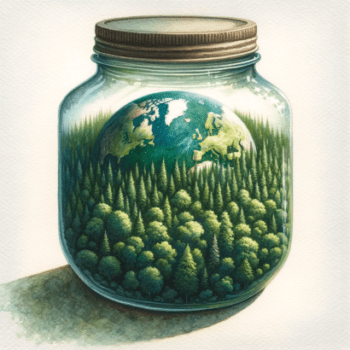
In this second artwork from the theme “The Planet Earth in a Jar, Showing Only Forests to Represent Nature,” we are presented with a vision that exquisitely marries the grandeur of the terrestrial with the intimacy of containment. The painting is a symphony of greens, where the planet is reimagined as a verdant orb, its surface a sea of trees, detailed with exquisite care to showcase the diversity and density of the world’s forests.
At the forefront, the forests emerge from the base of the jar, a lush landscape of varying shades of green that climb upwards and envelop the Earth in their embrace. Each tree is a testament to the vitality of Earth’s woodlands, standing tall and proud, stretching toward the lid that simultaneously protects and isolates. The trees closest to the jar’s curved glass are magnified, a clever use of perspective that highlights the interplay between the natural world and the way we perceive it through the lenses we construct.
Above this rich canopy, the Earth itself appears as a backdrop, the continents and oceans painted in a more subdued palette, suggesting that in this portrayal, the forests are the true protagonists. It’s as if the artist is drawing attention to the role of the forests as the lungs of our planet, vital and life-giving, worthy of our utmost reverence and care.
The jar, rendered with a rustic metal lid and a clarity that speaks to the purity of glass, encapsulates this world of green, a microcosm of Earth’s vast and vital wilderness. The transparency of the glass is impeccable, allowing light to permeate and cast a gentle glow upon the trees, symbolizing the light of awareness and understanding that must shine upon our environmental efforts.
A subtle shadow beneath the jar grounds the composition, giving it depth and a sense of presence on the paper it resides upon. This shadow is more than just a visual effect; it’s a metaphor for the imprint we leave upon nature, a reminder that our actions cast a longer shadow upon the environment than we often realize.
This painting, while enchanting in its beauty, carries a message of urgency: the forests we see so lush and alive within the jar are the very forests at risk outside of it. The artwork beckons the viewer to not only admire the majesty of these woodlands but also to recognize the imperative to protect and cherish them. It is an engaging invitation to ponder our place within the natural world and to act in its defense.
The planet Earth in a jar showing only forests to represent nature, Artwork 3
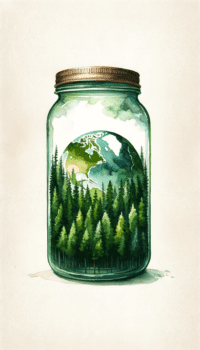
In this third piece of the “Earth in a Jar” series, under the theme “Showing Only Forests to Represent Nature,” the artwork presents a serene yet thought-provoking portrayal of our planet. The watercolor painting depicts Earth, partially obscured by a dense thicket of evergreen forests, nestled within the confines of a classic glass jar.
The forests are the dominant subject of this composition, taking center stage with a rich variety of greens that celebrate the diversity and life within. From the deep, shadowy pine greens to the soft, mossy hues, the trees are intricately detailed, suggesting a wild, untamed growth that spans the entire visible surface of the globe. Each tree is a brushstroke of life, contributing to the overall sense of a thriving, interconnected ecosystem.
The Earth itself peeks through the verdant foliage, with hints of blue and brown indicating the vast oceans and continents beyond. This subtle integration of the planet reminds the viewer of the forests’ global importance, acting as the Earth’s lungs and an essential component of the biosphere.
The jar is rendered with a realistic touch, from the threading on the bronze-colored lid to the gentle distortions of the glass. It casts a tangible shadow, grounding the work and adding depth to the scene. The shadow suggests the weight of the message within the painting: the fragility and beauty of our natural world and the care it requires from us.
A faint spillage of color beyond the jar’s base subtly breaks the confines of its form, perhaps symbolizing nature’s persistent resistance to human constraints. It’s a delicate reminder that despite our attempts to control and contain, nature exists beyond our constructs, wild and free.
This artwork is a beautiful blend of realism and symbolism, encapsulating a world within a world. It invites viewers to lose themselves in the forested landscape, to consider the power and importance of our planet’s woodlands, and to reflect on our role in preserving these vital natural sanctuaries.
The planet Earth in a jar showing only forests to represent nature, Artwork 4
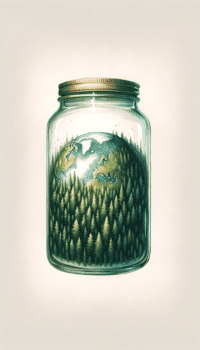
The fourth artwork in the third theme of the “Life in a Jar” series eloquently captures the essence of Earth’s verdant forests, epitomizing the theme “Showing Only Forests to Represent Nature.” Here, the viewer is invited to contemplate a world where the dense greenery of the planet’s woodlands is celebrated as the heart and soul of the natural world.
This piece is a testament to the timeless beauty of Earth’s forests, depicted as a sweeping expanse of conifers that rise to cradle the globe within their boughs. The painting is characterized by a symphony of green hues, from the deep, resonant tones of the ancient pine to the vibrant, life-affirming shades of new growth. The artist’s brushwork conveys not only the texture of the foliage but also the spirit of the forests – ancient, enduring, and ever-reaching toward the light.
The globe at the center of the composition is subtly detailed, with the soft, muted tones of the continents barely discernible beneath the dominating presence of the trees. This subtle rendition serves as a poignant reminder that the forests are not just parts of the Earth’s surface but vital, living entities that are integral to the health and wellbeing of the entire planet.
The jar that encases this world of green is more than a vessel; it is a lens through which we are invited to view our environment. With its unadorned glass and simple metal lid, the jar is a symbol of the barriers we construct – both physical and conceptual – that separate us from fully engaging with the natural world.
A delicate shadow beneath the jar adds to the realism of the watercolor and suggests a presence that is both tangible and metaphorical. It reminds us of the weight of responsibility we bear for the stewardship of such treasure and the shadows we cast on the environment through our actions and inactions.
In this artwork, the artist offers a serene yet powerful reminder of nature’s omnipresence and the reverence it commands. It is an invitation to the viewer to reflect on our relationship with the Earth’s forests – to protect, to cherish, and to ensure that they continue to envelop the world with their life-giving splendor.
Summary:
Through a series of four masterful watercolors, we are taken on a journey that is as much about introspection as it is about environmental appreciation. From the dense underbrush to the towering canopies, each stroke of the brush brings to life the verdant diversity that clothes our planet. The artworks showcase Earth as a living, breathing organism, with forests pulsating at its core. The glass jar, a recurring motif, stands as a symbol of our desire to observe, to protect, and to sometimes distance ourselves from the wildness of nature. As viewers, we are compelled to reflect on our own existence—rooted and yet so often disconnected from these natural sanctuaries.
Conclusion:
As the article comes to a close, we are left with a lingering sense of awe for the silent giants that anchor our world and a renewed awareness of the delicate balance we must maintain with our environment. The “Earth in a Jar” theme urges us to acknowledge the silent isolation of nature as it is juxtaposed against the bustling loneliness of human life. It prompts us to question the jars we place around ourselves and nature—whether they serve as protection or as barriers. Ultimately, these artworks stand as a call to action: to break free from our self-imposed confines, to reconnect with the natural world, and to ensure that the forests, which have flourished long before us, continue to thrive for generations to come.
Support the Project:
The “Life in a Jar: An Artistic Examination of Social Isolation” project transcends the boundaries of art, inviting us into a deeper conversation about our planet and our place within it. We can all play a part in sustaining this profound narrative. Here are ways to support the project:
- Financial Contributions: Consider making a financial contribution to the project. Your donations will fuel the continuation of this creative exploration and help bring more themes to life. Every donation, big or small, makes a difference and allows the artists to delve deeper into this critical discourse.
- Artwork Acquisition: Each painting in the “Earth in a Jar” series is more than an image; it’s a story, a dialogue, a piece of a larger puzzle. By purchasing an individual artwork or a complete set, you not only become a custodian of this tale but also support the artists and their vision directly. These pieces are not just decor; they are conversations starters, heirlooms, and legacies.
- Join the Dialogue: After reading about the “Earth in a Jar” artworks, start a discussion with friends, family, or online communities. Share your thoughts, feelings, and insights. The conversation that begins in contemplation can lead to action and awareness, which are pivotal in addressing the themes of isolation and environmental responsibility.
- Spread the Word: If the “Life in a Jar” project resonates with you, become an advocate for its vision. Share articles, posts, and images on social media. Invite others to join the project community, to experience the art, and to become part of the growing conversation. The more we talk about these issues, the more we can do to address them.
- Host an Exhibition: If you have the means or connections, consider hosting an exhibition of the “Earth in a Jar” series in your local community center, gallery, or school. Physical exhibitions can bring people together and create a space for dialogue and connection. Please contact us to get started.
- Volunteer Your Skills: Are you a writer, a social media influencer, or an event organizer? Lend your skills to the project. By offering your expertise, you can help amplify the project’s message and reach a wider audience.
In whatever way you choose to support, you become part of a collective effort to not only appreciate the profound beauty of our world but to also preserve it. Together, through art and dialogue, we can inspire change and foster a more connected and conscious global community.

